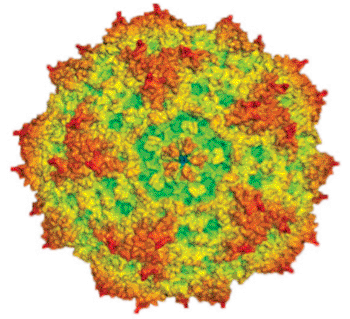Histone Deacetylase Inhibitors Boost Parvovirus Cancer Killing Action
|
By LabMedica International staff writers Posted on 28 Oct 2013 |

Image: Computer-generated representation of parvovirus H-1 (H-1PV) (Photo courtesy of Dr. Antonio Marchini, German Cancer Research Center).
The anticancer action of parvoviruses can be dramatically improved by co-treating cancer cells with parvovirus and histone deacetylase inhibitors (HDACIs) such as valproic acid.
The rat parvovirus H-1PV has oncolytic and tumor-suppressive properties potentially exploitable in cancer therapy. This possibility is being explored by cancer researchers, and while results have been encouraging, they have found that it is necessary to improve the cancer-killing capability of the virus.
Towards this end, investigators at the German Cancer Research Center (Heidelberg) have sought drugs or drug combinations that would improve the ability of parvoviruses to kill cancer cells. In a paper published in the September 17, 2013, online edition of the journal EMBO Molecular Medicine they described the effect of the histone deacetylase inhibitor valproic acid (VPA) on the interaction between H-1PV and human cervical carcinoma and pancreatic carcinoma cell lines.
The investigators showed that co-treatment of cultures with the parvovirus and VPA boosted the ability of the virus to kill a range of human cervical carcinoma and pancreatic carcinoma cell lines by inducing oxidative stress, DNA damage, and apoptosis. Furthermore, in rat and mouse xenograft models, H-1PV/VPA co-treatment strongly inhibited tumor growth promoting complete tumor remission in all co-treated animals. In contrast, animals treated with the same virus dose without the drug displayed no regression, not even when a 20-times higher dose of viruses was administered.
At the molecular level, the investigators found that the parvovirus nonstructural protein NS1 modulated viral transcription and cytotoxicity, both of which were enhanced by VPA treatment. NS1 was acetylated at residues K85 and K257 and addition of VPA correlated with an enhanced rate of NS1 acetylation. In contrast, amino-acid substitution of the two acetylation sites strongly impaired NS1-mediated viral gene transcription, viral replication, and cytotoxicity. VPA induced hyper-acetylation of NS1, which converted the protein into a more active polypeptide.
"The synergistic effect of a combination of parvoviruses and valproic acid enables us to deliver both the viruses and the drug at low doses, which prevents severe side effects," said senior author Dr. Antonio Marchini, a principle investigator in virology at the German Cancer Research Center. "The results are encouraging us to carry out further tests of this combination therapy. We believe it has the potential to arrest tumor growth in severe cases of cancer. We obtained impressive results in preclinical trials with parvovirus H-1 in brain tumors. However, the oncolytic effect of the viruses is weaker in other cancers. Therefore, we are searching for ways to increase the therapeutic potential of the viruses."
Related Links:
German Cancer Research Center
The rat parvovirus H-1PV has oncolytic and tumor-suppressive properties potentially exploitable in cancer therapy. This possibility is being explored by cancer researchers, and while results have been encouraging, they have found that it is necessary to improve the cancer-killing capability of the virus.
Towards this end, investigators at the German Cancer Research Center (Heidelberg) have sought drugs or drug combinations that would improve the ability of parvoviruses to kill cancer cells. In a paper published in the September 17, 2013, online edition of the journal EMBO Molecular Medicine they described the effect of the histone deacetylase inhibitor valproic acid (VPA) on the interaction between H-1PV and human cervical carcinoma and pancreatic carcinoma cell lines.
The investigators showed that co-treatment of cultures with the parvovirus and VPA boosted the ability of the virus to kill a range of human cervical carcinoma and pancreatic carcinoma cell lines by inducing oxidative stress, DNA damage, and apoptosis. Furthermore, in rat and mouse xenograft models, H-1PV/VPA co-treatment strongly inhibited tumor growth promoting complete tumor remission in all co-treated animals. In contrast, animals treated with the same virus dose without the drug displayed no regression, not even when a 20-times higher dose of viruses was administered.
At the molecular level, the investigators found that the parvovirus nonstructural protein NS1 modulated viral transcription and cytotoxicity, both of which were enhanced by VPA treatment. NS1 was acetylated at residues K85 and K257 and addition of VPA correlated with an enhanced rate of NS1 acetylation. In contrast, amino-acid substitution of the two acetylation sites strongly impaired NS1-mediated viral gene transcription, viral replication, and cytotoxicity. VPA induced hyper-acetylation of NS1, which converted the protein into a more active polypeptide.
"The synergistic effect of a combination of parvoviruses and valproic acid enables us to deliver both the viruses and the drug at low doses, which prevents severe side effects," said senior author Dr. Antonio Marchini, a principle investigator in virology at the German Cancer Research Center. "The results are encouraging us to carry out further tests of this combination therapy. We believe it has the potential to arrest tumor growth in severe cases of cancer. We obtained impressive results in preclinical trials with parvovirus H-1 in brain tumors. However, the oncolytic effect of the viruses is weaker in other cancers. Therefore, we are searching for ways to increase the therapeutic potential of the viruses."
Related Links:
German Cancer Research Center
Latest BioResearch News
- Genome Analysis Predicts Likelihood of Neurodisability in Oxygen-Deprived Newborns
- Gene Panel Predicts Disease Progession for Patients with B-cell Lymphoma
- New Method Simplifies Preparation of Tumor Genomic DNA Libraries
- New Tool Developed for Diagnosis of Chronic HBV Infection
- Panel of Genetic Loci Accurately Predicts Risk of Developing Gout
- Disrupted TGFB Signaling Linked to Increased Cancer-Related Bacteria
- Gene Fusion Protein Proposed as Prostate Cancer Biomarker
- NIV Test to Diagnose and Monitor Vascular Complications in Diabetes
- Semen Exosome MicroRNA Proves Biomarker for Prostate Cancer
- Genetic Loci Link Plasma Lipid Levels to CVD Risk
- Newly Identified Gene Network Aids in Early Diagnosis of Autism Spectrum Disorder
- Link Confirmed between Living in Poverty and Developing Diseases
- Genomic Study Identifies Kidney Disease Loci in Type I Diabetes Patients
- Liquid Biopsy More Effective for Analyzing Tumor Drug Resistance Mutations
- New Liquid Biopsy Assay Reveals Host-Pathogen Interactions
- Method Developed for Enriching Trophoblast Population in Samples
Channels
Clinical Chemistry
view channel
Noninvasive Blood-Glucose Monitoring to Replace Finger Pricks for Diabetics
People with diabetes often need to measure their blood glucose multiple times a day, most commonly through finger-prick blood tests or implanted sensors. These methods can be painful, inconvenient, and... Read more
POC Breath Diagnostic System to Detect Pneumonia-Causing Pathogens
Pseudomonas aeruginosa is a major cause of hospital-acquired and ventilator-associated pneumonia, particularly in lung transplant recipients and patients with structural lung disease. Its ability to form... Read moreMolecular Diagnostics
view channel
World's First NGS-Based Diagnostic Platform Fully Automates Sample-To-Result Process Within Single Device
Rapid point-of-need diagnostics are of critical need, especially in the areas of infectious disease and cancer testing and monitoring. Now, a direct-from-specimen platform that performs genomic analysis... Read more
Rapid Diagnostic Breakthrough Simultaneously Detects Resistance and Virulence in Klebsiella Pneumoniae
Antibiotic resistance is a steadily escalating threat to global healthcare, making common infections harder to treat and increasing the risk of severe complications. One of the most concerning pathogens... Read moreHematology
view channel
MRD Tests Could Predict Survival in Leukemia Patients
Acute myeloid leukemia is an aggressive blood cancer that disrupts normal blood cell production and often relapses even after intensive treatment. Clinicians currently lack early, reliable markers to predict... Read more
Platelet Activity Blood Test in Middle Age Could Identify Early Alzheimer’s Risk
Early detection of Alzheimer’s disease remains one of the biggest unmet needs in neurology, particularly because the biological changes underlying the disorder begin decades before memory symptoms appear.... Read more
Microvesicles Measurement Could Detect Vascular Injury in Sickle Cell Disease Patients
Assessing disease severity in sickle cell disease (SCD) remains challenging, especially when trying to predict hemolysis, vascular injury, and risk of complications such as vaso-occlusive crises.... Read more
ADLM’s New Coagulation Testing Guidance to Improve Care for Patients on Blood Thinners
Direct oral anticoagulants (DOACs) are one of the most common types of blood thinners. Patients take them to prevent a host of complications that could arise from blood clotting, including stroke, deep... Read moreImmunology
view channel
Blood Test Could Identify Colon Cancer Patients to Benefit from NSAIDs
Colon cancer remains a major cause of cancer-related illness, with many patients facing relapse even after surgery and chemotherapy. Up to 40% of people with stage III disease experience recurrence, highlighting... Read moreBlood Test Could Detect Adverse Immunotherapy Effects
Immune checkpoint inhibitors have transformed cancer treatment, but they can also trigger serious immune-related adverse events that damage healthy organs and may become life-threatening if not detected early.... Read moreMicrobiology
view channel
New UTI Diagnosis Method Delivers Antibiotic Resistance Results 24 Hours Earlier
Urinary tract infections affect around 152 million people every year, making them one of the most common bacterial infections worldwide. In routine medical practice, diagnosis often relies on rapid urine... Read more
Breakthroughs in Microbial Analysis to Enhance Disease Prediction
Microorganisms shape human health, ecosystems, and the planet’s climate, yet identifying them and understanding how they are related remains a major scientific challenge. Even with modern DNA sequencing,... Read morePathology
view channel
AI Tool Simultaneously Identifies Genetic Mutations and Disease Type
Interpreting genetic test results remains a major challenge in modern medicine, particularly for rare and complex diseases. While existing tools can indicate whether a genetic mutation is harmful, they... Read more
Rapid Low-Cost Tests Can Prevent Child Deaths from Contaminated Medicinal Syrups
Medicinal syrups contaminated with toxic chemicals have caused the deaths of hundreds of children worldwide, exposing a critical gap in how these products are tested before reaching patients.... Read more
Tumor Signals in Saliva and Blood Enable Non-Invasive Monitoring of Head and Neck Cancer
Head and neck cancers are among the most aggressive malignancies worldwide, with nearly 900,000 new cases diagnosed each year. Monitoring these cancers for recurrence or relapse typically relies on tissue... Read moreTechnology
view channel
Diagnostic Chip Monitors Chemotherapy Effectiveness for Brain Cancer
Glioblastoma is one of the most aggressive and fatal brain cancers, with most patients surviving less than two years after diagnosis. Treatment is particularly challenging because the tumor infiltrates... Read more
Machine Learning Models Diagnose ALS Earlier Through Blood Biomarkers
Amyotrophic lateral sclerosis (ALS) is a rapidly progressive neurodegenerative disease that is notoriously difficult to diagnose in its early stages. Early symptoms often overlap with other neurological... Read moreIndustry
view channel
BD and Penn Institute Collaborate to Advance Immunotherapy through Flow Cytometry
BD (Becton, Dickinson and Company, Franklin Lakes, NJ, USA) has entered into a strategic collaboration with the Institute for Immunology and Immune Health (I3H, Philadelphia, PA, USA) at the University... Read more
























